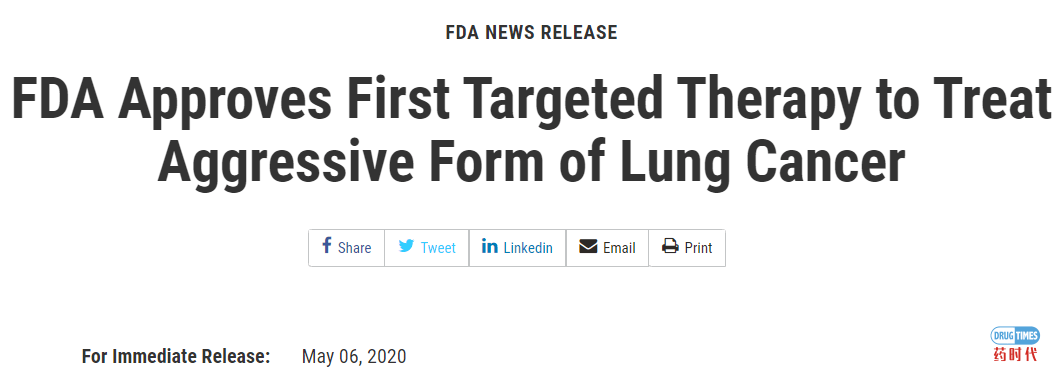
药时代上海报道
美国时间2020年5月6日,美国食品药品监督管理局加速批准了诺华公司研发的Tabrecta(capmatinib)用于治疗已扩散到身体其它部位的成年非小细胞肺癌(NSCLC)患者。Tabrecta是首个获得FDA批准的具有特定突变(导致间充质-上皮转化或MET外显子14跳跃突变)的NSCLC疗法。

Today, the U.S. Food and Drug Administration approved Tabrecta (capmatinib) for the treatment of adult patients with non-small cell lung cancer (NSCLC) that has spread to other parts of the body. Tabrecta is the first FDA-approved therapy to treat NSCLC with specific mutations (those that lead to mesenchymal-epithelial transition or MET exon 14 skipping).
The FDA also approved the FoundationOne CDx assay (F1CDx) as a companion diagnostic for Tabrecta today. Most patients had tumor samples that were tested for mutations that lead to MET exon 14 skipping using local tests and confirmed with the F1CDx, which is a next-generation sequencing based in vitro diagnostic device that is capable of detecting several mutations, including mutations that lead to MET exon 14 skipping.
“Lung cancer is increasingly being divided into multiple subsets of molecularly defined populations with drugs being developed to target these specific groups,” said Richard Pazdur, M.D., director of the FDA’s Oncology Center of Excellence and acting director of the Office of Oncologic Diseases in the FDA’s Center for Drug Evaluation and Research. “Tabrecta is the first approval specifically for the treatment of patients with non-small cell lung cancer whose tumors have mutations that lead to MET exon 14 skipping. This patient population now has an option for a targeted therapy, which they didn’t have prior to today.”
NSCLC is a disease in which malignant cancer cells form in the tissues of the lung. It is the most common type of lung cancer with up to 90% of all lung carcinomas falling into the non-small cell category. NSCLC occurs when healthy cells become abnormal and grow rapidly. One danger of this form of cancer is that there’s a high likelihood that the cancer cells will spread from the lungs to other organs and body parts. Cancer metastasis consists of a sequential series of events, and MET exon 14 skipping is recognized as a critical event for metastasis of carcinomas. Mutations leading to MET exon 14 skipping are found in 3-4% of patients with lung cancer.
Tabrecta is a kinase inhibitor, meaning it functions by blocking a key enzyme that results in helping to stop the tumor cells from growing. The FDA approved Tabrecta based on the results of a clinical trial involving patients with NSCLC with mutations that lead to MET exon 14 skipping, epidermal growth factor receptor (EGFR) wild-type and anaplastic lymphoma kinase (ALK) negative status, and at least one measurable lesion.
During the clinical trial, participants received Tabrecta 400 mg orally twice daily until disease progression or unacceptable toxicity. The major efficacy outcome measure was overall response rate (ORR), which reflects the percentage of participants that had a certain amount of tumor shrinkage. An additional efficacy outcome measure was duration of response (DOR). The efficacy population included 28 patients who had never undergone treatment for NSCLC and 69 previously treated patients. The ORR for the 28 participants was 68%, with 4% having a complete response and 64% having a partial response. The ORR for the 69 participants was 41%, with all having a partial response. Of the responding participants who had never undergone treatment for NSCLC, 47% had a duration of response lasting 12 months or longer compared to 32.1% of the responding participants who had been previously treated.
Common side effects for patients taking Tabrecta are peripheral edema (leg swelling), nausea, fatigue, vomiting, dyspnea (shortness of breath) and decreased appetite.
Tabrecta may cause serious side effects including interstitial lung disease (a group of lung conditions that causes scarring of lung tissues) or pneumonitis (inflammation of the lung tissue). Tabrecta should be permanently discontinued in patients with these side effects. Tabrecta may also cause hepatotoxicity (damage to liver cells), and health care professionals should monitor a patient’s liver function tests prior to starting and when taking Tabrecta. If a patient experiences hepatotoxicity, Tabrecta should be withheld, dose reduced or permanently discontinued. Based on a clear positive signal for phototoxicity (drug-induced damage to cells that is enhanced by UV light) in laboratory studies in cells, patients may be more sensitive to sunlight and should be advised to take precautions to cover their skin and use sunscreen and not to tan while taking Tabrecta.
Tabrecta may cause harm to a developing fetus or newborn baby. Health care professionals should advise pregnant women of this risk and should advise both females of reproductive potential and male patients with female partners of reproductive potential to use effective contraception during treatment with Tabrecta and for one week after the last dose.
“In the face of the COVID-19 pandemic, our regular work on reviewing treatments for patients with cancer is moving forward,” said Pazdur. “The impact may be hardest on those with acute or chronic medical conditions and those with weakened immune systems, such as that caused by cancer and some forms of cancer treatment. We are working to address critical issues for patients with cancer and their health care providers and continuing to expedite oncology product development in this critical time.”
Tabrecta was approved under the Accelerated Approval pathway, which provides for the approval of drugs that treat serious or life-threatening diseases and generally provide a meaningful advantage over existing treatments. The FDA granted this application Breakthrough Therapy designation, which expedites the development and review of drugs that are intended to treat a serious condition, when preliminary clinical evidence indicates that the drug may demonstrate substantial improvement over available therapies, and Priority Review designation. Tabrecta received Orphan Drug designation, which provides incentives to assist and encourage the development of drugs for rare diseases.
The FDA granted approval of Tabrecta to Novartis Pharmaceuticals Corporation. The approval of the F1CDx companion diagnostic was granted to Foundation Medicine, Inc.
(Source:FDA 版权归拥有者。衷心感谢!)
END
- 更多活动策划筹备中


发布者:药时代,转载请首先联系contact@drugtimes.cn获得授权



 为好文打赏 支持药时代 共创新未来!
为好文打赏 支持药时代 共创新未来! 
